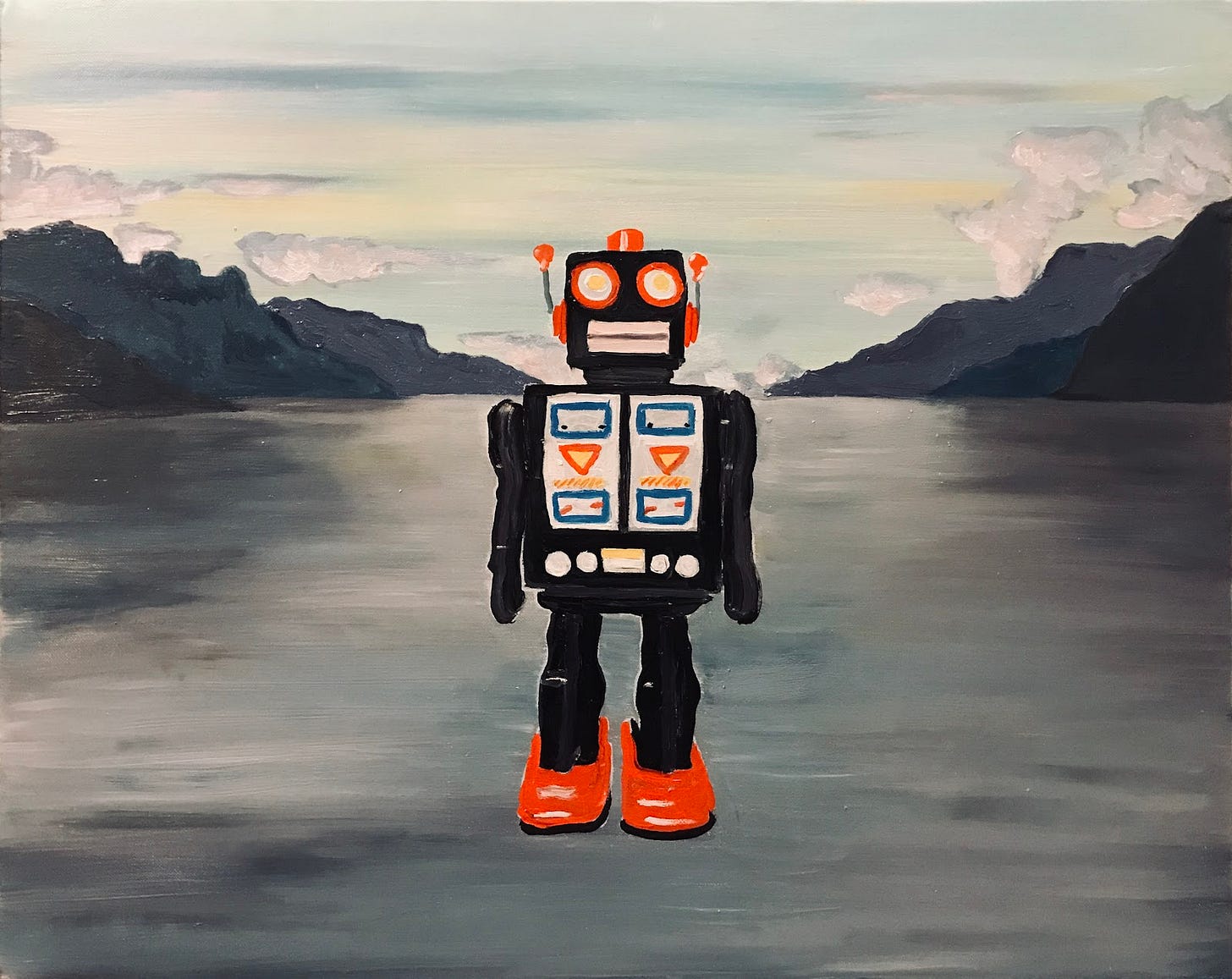This article previously appeared in Garage/Vice magazine.
Spoiler Alert: Plot points are discussed in this review.
My cousin Roscoe, a film-student, taught me a valuable lesson about movie remakes. I was tooth-gnashing for days after seeing the remake of Mad Max: “Why do they suddenly have fucking 3D printer-based, ultra-rococo, Balmain-esque costume design capabilities in the post-apocalyptic Australian outback?!”
“Try watching it again,” he counseled. “Pretend that you’ve never seen the original.”
I did. Viewing it as a film unrelated to Mad Max, I enjoyed the remake 40% more.
I employed this mindset when I went to see Bladerunner 2049.
Ridley Scott’s original Bladerunner was, in 1982 (and arguably still is) the most important film in the orthodoxy of subculture cinema. It was a perfect realization of a novel by sci-fi prophet Philip K. Dick. In its brilliance, audacity and prescience, Blade Runner didn’t just imprint on the collective psyche of my generation — it become etched in stone tablets.
Decades before other filmmakers started making bleak post-apocalyptic movies asking questions about the moral implications of what we now call “the Singularity” (artificial intelligence becoming self-aware ) the original Bladerunner kickstarted the conversation about the ethics of engineering consciousness: if a machine can feel pain, love and grieve - at what point is it not a machine? If artificial consciousness is capable of knowing itself, does it transcend the artificial?
In Bladerunner 2049 dispenses with this AI, “how-many-dead-Replicants-can-dance-on-the-head-of-a-pin” liturgical frippery, and goes…somewhere else.
There is a plot in this movie somewhere.
Older model replicants - still prone to rebellion from their lives on slave colonies - are still being ‘retired’ (i.e. shot) by Blade Runners, a special arm of law enforcement.
Ryan Gosling is “K” - the newest model of replicant Blade Runner, improved to be more subservient than older models. (This is perfect casting; Gosling’s face is as motionlessly, unnaturally neutral as a Noh mask in most roles.)
The tale begins, in no particular hurry, when on assignment, K discovers the remains of a pregnant replicant female and human/replicant hybrid child, who died together during an emergency c-section.
This apparently has earth-shattering implications, even when all colonized worlds have already been pre-shat on. K is asked to make the corpses and any relatable evidence disappear, because this revelation of reproductive capability will create a war between humans and the replicants. It’s not tremendously clear why this is. Perhaps, if replicants can procreate, stock will plummet for the Wallace and Tyrell Corporations who manufacture them. Perhaps, if replicants can autonomously reproduce, they will object more strenuously to lives of slavery. It’s hard to say.
The motivations are muddy and opaque even after coming home and reading a bunch of articles trying to clarify them. Questions arise when trying to locate the script’s logic and reason. Like: why wouldn’t replicants be capable of reproduction, since they are bio-engineered to be indistinguishable from humans? Why does this inter-breeding constitute a dangerous “miracle?”
(I figured the trouble was something like the Monsanto “suicide seed” scandal; crops/people/replicants can’t be allowed to procreate, because if life was allowed to flourish naturally, new crop seeds/slaves wouldn’t need to be purchased annually. This, however, is pure speculation on my part.)
This focus on controlled reproduction is especially bewildering given the sexual politics of this sequel - a topic which consumes vast quantities of screen-time, but has no recognizably direct impact on or particular relation to the plot.
K spends most of his time in a depressing convenience apartment with his girlfriend Joi - a super-hot hologram (played by the comely Ana de Armas) who can change outfits at the speed of fickleness: she’s Holy June Cleaver in ironed apron, serving hubby a steamy translucent pot-roast - then, in the blink of a toggle-switch, she’s a sassy sex-toy in a platinum stripper wig, eager for you to grope through her metallic mini-dress.
Since Joi, as a hologram, is atomically challenged, she cheerfully brings prostitutes home to K as gifts, then “syncs”with them: superimposing her image onto the prostitute and moving in exact unison with her, so K can get his biogenetic weird on, and enjoy exercising his robo-penis in an ersatz but tangible vagina module. (For some reason Joi can’t have her own, despite the fact that “pleasure model” replicants like Daryl Hannah’s ‘Priss’ were commonplace in the 1982 film.)
Joi is unable to leave the house, because her hologram is implanted with some kind of electric dog-collar boundary that makes her sputter out like an old UHF channel if she ventures past the home wi-fi signal (and what man wouldn’t pay extra for that?) For life beyond the transom, Joi needs a special add-on remote widget. However, once the widget allows her projection to go outside, Joi’s virtual life is jeopardized; if the gadget is lost, Joi’s program will be gone forever, despite the fact that she is a popular product of the Wallace Corporation, and as mass-produced a fantasy playmate as Barbie. (This is evidenced by multiple skyscraper-size holographic billboards of Joi, bending over in cyber-panties. Every home should have one.) Losing the remote to your mobilized Joi subjects her to death, because even though she’s as ubiquitous a corporate commodity as corn-syrup— she’s not backed up anywhere. There are no Clouds of Joi - you can’t just buy the Fuckstation IV Joistick and boot her up again.
(Yes, you can take the Chekov Gun-in-Scene-1 cliché and graft it straight on to Joi’s existential remote-control. When she perishes, it’s as moving as unplugging a toaster.)
On a macro level, the film seems to be commenting on the cheapening of life at all levels of nature - female life in particular.
The Wallace Corporation is a Monsanto-like operation; it controls the birthing of full-grown replicants (by dropping them somewhat violently out of transparent plastic intestines onto a shiny parquet floor, naked, beautifully shaven, fully bukkake’d in industrial mucus and birthy glycerine) and, more importantly, the production of food.
The colonized planets, for all their sketchy commercial activity, are little more than extravagantly rendered, radioactive vacant lots; all earth is scorched, all winters are nuclear. The jigsaw puzzle-maps of farmlands seen from overhead are all fifty shades of Man’s Dominion over Nature. Optimum soul-crushing dreariness is meticulously realized through lavish veneers of powdery bomb-silt and other obsessively textured, poisonous nonscapes.
There is no wood at all, save for a dead white tree where K found the corpses, a mnemonic talisman of a little carved horse of overprecious importance, and the boardroom of the Wallace corporation, which resembles a vast, shellacked birds-eye maple dry-sauna over an agitated reflecting pond, under-lit to keep the shiny golden walls constantly wiggling. There is a small wooden conversation-island in the pond’s center, with some le Courbousier-knockoff chairs surrounding a rolling wet-bar.
The Wallace corporation is run by psychopathic industrialist Niander Wallace, played in cubist spasms of actorly evil by Jared Leto in milky cataract contact-lenses.
Despite Leto’s gnawing portrayal (he chews his minimalist wooden scenery like a robo-beaver unto pulp and damnation) and the mesmerizingly expensive post-apocalyptic mis en scène, the new Blade Runner offers very little to connect with in the way of human drama.
Director Denis Villeneuve's vision for the film demands excruciatingly ultra-ponderous pacing, suggestive of Deeper Philosophical Meanings. Mostly, it’s merely excruciating.
You can steer multiple aircraft carriers between the spaces the dialogue requires for simple questions to be asked and reluctantly answered. In place of watching the actor think, for example, K’s emotions are suggested by long lingering shots of the back of his head. Then he slowly raises his head (and 80 seconds of your life just went by that you’ll never get back or fully understand, but whomever de-linted his overcoat was really on it.)
Finally, after what seems like 23 hours into the 180 minute spectacle, Harrison Ford appears in all his crotchety old glory. K needs to apprehend Deckard in connection to the Miracle Corpse, which belongs to his old electric girlfriend, Rachael. Since Rachael’s battery became unjumpable, Deckard has been drinking himself to death in the red-dust-busted lounge-Chernobyl that once was Las Vegas. 3-D holograms of Elvis and Marilyn Monroe perform in eternity, in adjustable sizes; you can have your own performing Sinatra under a little glass bell like a stuffed frog in a mariachi suit. Deckard and K confront each other in a bar stacked with forgeries of art masterpieces (Get it? Did anyone ever read “The Recognitions” by William Gaddis? How about “Simulacra/Simulacrum?” No? The same book Neo kept his drugs in, in the Matrix? Never mind. )
The film’s most jarring moment is a special psychological torture designed for Deckard by the unhinged Jared Leto: they trot out vintage Sean Young, the replicant who fell in love with Deckard in the original. She is unaged and unchanged, and this is real Freudian uncanny-territory. Rachael was recreated with CGI perfection by superimposing images of Sean Young circa 1982 onto actress Lauren Peta - and it works.
It’s disturbing for all kinds of reasons, and not just because K’s electric sheep of a live-in-girlfriend lets hookers use her face while fucking him. The message here, ladies, is that you’ve got approximately 4 years where you’re of any value whatsoever. Harrison Ford gets to slobber on your “skin-job” for eternity, as fat and purple as he gets — but ladies, you’d better get your infinitely replaceable ass uploaded while it’s still en-Joi-able.
“Sometimes, to love somebody, you have to be a stranger,” says Deckerd, in what is supposed to be the film’s deepest moment of dialogue.
What I heard was the translation, to wit: Intimacy-phobic or merely chauvinistic males, rejoice: Real women are going the way of the Betamax.
I sat through all 26,000 hours of Bladerunner 2049 determined to keep my mind pried open, Ludovico Technique-style.
I left the theater scratching my nails on the cinema wall. It was like sitting shivah for the corpse of the original Bladerunner, only much longer and more agonizing.
To be fair, the art direction (aside from a few highly derivative giant-watch-gears-on-rusty-fire-escapes, Steampunk 101 interiors, and some WALL-E offworld garbage dumps ) is generally superlative. Laurels should be torched into toxic ash and sifted with annoying precision onto the director of photography. The best part of the movie is the fact that it is visually comparable to watching Tarkovsky’s Solaris — only in super slo-mo.
The independently produced original Blade Runner, which had exponentially less money backing it, staked out its own visual signature. It’s cold smoky haze and sickly blue back-lighting made everything look bureaucratic and bloodless; Ridley Scott invented this iconic neon-noire. But more importantly, the original Blade Runner had something the overwrought sequel doesn’t seem to have budgeted into its production:
it had soul.
Art: “The Loch Ness Robot” oil on linen by Cintra Wilson, 2020















Share this post